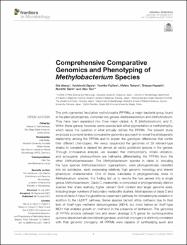Comprehensive Comparative Genomics and Phenotyping of Methylobacterium Species

Göster/
Tarih
2021Yazar
Alessa, OlaOgura, Yoshitoshi
Fujitani, Yoshiko
Takami, Hideto
Hayashi, Tetsuya
Şahin, Nurettin
Tani, Akio
Üst veri
Tüm öğe kaydını gösterKünye
Alessa O, Ogura Y, Fujitani Y, Takami H, Hayashi T, Sahin N and Tani A (2021) Comprehensive Comparative Genomics and Phenotyping of Methylobacterium Species. Front. Microbiol. 12:740610. doi: 10.3389/fmicb.2021.740610Özet
The pink-pigmented facultative methylotrophs (PPFMs), a major bacterial group found in the plant phyllosphere, comprise two genera: Methylobacterium and Methylorubrum. They have been separated into three major clades: A, B (Methylorubrum), and C. Within these genera, however, some species lack either pigmentation or methylotrophy, which raises the question of what actually defines the PPFMs. The present study employed a comprehensive comparative genomics approach to reveal the phylogenetic relationship among the PPFMs and to explain the genotypic differences that confer their different phenotypes. We newly sequenced the genomes of 29 relevant-type strains to complete a dataset for almost all validly published species in the genera. Through comparative analysis, we revealed that methylotrophy, nitrate utilization, and anoxygenic photosynthesis are hallmarks differentiating the PPFMs from the other Methylobacteriaceae. The Methylobacterium species in clade A, including the type species Methylobacterium organophilum, were phylogenetically classified into six subclades, each possessing relatively high genomic homology and shared phenotypic characteristics. One of these subclades is phylogenetically close to Methylorubrum species; this finding led us to reunite the two genera into a single genus Methylobacterium. Clade C, meanwhile, is composed of phylogenetically distinct species that share relatively higher percent G+C content and larger genome sizes, including larger numbers of secondary metabolite clusters. Most species of clade C and some of clade A have the glutathione-dependent pathway for formaldehyde oxidation in addition to the H4MPT pathway. Some species cannot utilize methanol due to their lack of MxaF-type methanol dehydrogenase (MDH), but most harbor an XoxF-type MDH that enables growth on methanol in the presence of lanthanum. The genomes of PPFMs encode between two and seven (average 3.7) genes for pyrroloquinoline quinone-dependent alcohol dehydrogenases, and their phylogeny is distinctly correlated with their genomic phylogeny. All PPFMs were capable of synthesizing auxin and did not induce any immune response in rice cells. Other phenotypes including sugar utilization, antibiotic resistance, and antifungal activity correlated with their phylogenetic relationship. This study provides the first inclusive genotypic insight into the phylogeny and phenotypes of PPFMs.

















